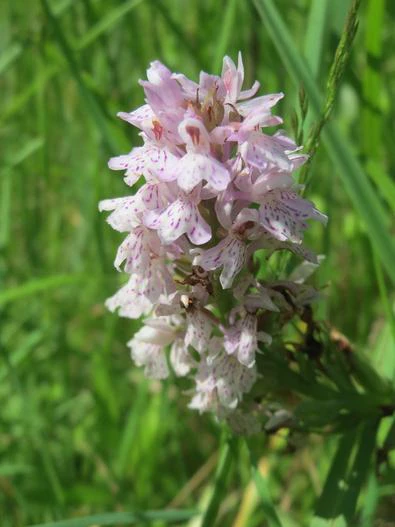Common Spotted Orchid
(Dactylorhiza maculata subsp. fuchsii)
Common Spotted Orchid (Dactylorhiza maculata subsp. fuchsii)
/
/

Andreas Rockstein
CC BY-SA 2.0
Image By:
Andreas Rockstein
Recorded By:
Copyright:
CC BY-SA 2.0
Copyright Notice:
Photo by: Andreas Rockstein | License Type: CC BY-SA 2.0 | License URL: https://creativecommons.org/licenses/by-sa/2.0/ | Uploader: anro0002 | Publisher: Flickr









Estimated Native Range
Climate Requirements
| • Precipitation | 32" - 39" |
| • High Temp. | 63°F - 75°F |
| • Low Temp. | 10°F - 35°F |
Summary
Dactylorhiza maculata subsp. fuchsii, commonly known as Common Spotted Orchid or Fuchs’ Dactylorhiza, is a perennial herb that is native to a range of habitats across Europe and Asia, including damp meadows, marshes, fens, and woodland clearings, as well as heathland on calcareous or neutral soil. It typically grows at a moderate rate to a height of 1-2 feet (0.3-0.6 meters) and features a rosette of lance-shaped leaves often spotted with dark markings. The plant produces dense spikes of pink or purple flowers that are highly showy and bloom in the summer, attracting pollinators such as bees and butterflies.
The Common Spotted Orchid is valued for its ornamental flowers and is used in wildflower gardens, naturalized areas, and for bog or water garden margins. It requires consistent moisture and can tolerate a range of light conditions from full sun to part shade. It thrives in medium draining loam or clay soils that are rich in organic matter. While generally low-maintenance, it can be susceptible to slug and snail damage. This orchid is not typically prone to diseases but can suffer from root rot if overwatered or planted in poorly draining soil. It is not known to be invasive and is often propagated by division or from seed, with the latter requiring a symbiotic relationship with specific soil fungi to germinate successfully.CC BY-SA 4.0
The Common Spotted Orchid is valued for its ornamental flowers and is used in wildflower gardens, naturalized areas, and for bog or water garden margins. It requires consistent moisture and can tolerate a range of light conditions from full sun to part shade. It thrives in medium draining loam or clay soils that are rich in organic matter. While generally low-maintenance, it can be susceptible to slug and snail damage. This orchid is not typically prone to diseases but can suffer from root rot if overwatered or planted in poorly draining soil. It is not known to be invasive and is often propagated by division or from seed, with the latter requiring a symbiotic relationship with specific soil fungi to germinate successfully.CC BY-SA 4.0
Plant Description
- Plant Type: Herb
- Height: 1-2 feet
- Width: 0.5-1 feet
- Growth Rate: Moderate
- Flower Color: Pink, Purple
- Flowering Season: Summer
- Leaf Retention: Deciduous
Growth Requirements
- Sun: Full Sun, Part Shade
- Water: Medium
- Drainage: Medium
Common Uses
Border Plant, Butterfly Garden, Low Maintenance, Water Garden
Natural Habitat
Damp meadows, marshes, fens, woodland clearings, and heathland on calcareous or neutral soil
Other Names
Common Names: Fuchs’ Spotted Orchid, Fuchs’ Dactylorhiza
Scientific Names: Dactylorhiza maculata subsp. fuchsii, ? meyerae, Dactylanthera chevallieriana nothosubsp. somersetensis, Dactylorchis fuchsii, Dactylorchis fuchsii subsp. hebridensis, Dactylorchis fuchsii subsp. okellyi, Dactylorchis fuchsii subsp. sooana, Dactylorchis maculata subsp. fuchsii, Dactylorchis okellyi
GBIF Accepted Name: Dactylorhiza maculata subsp. fuchsii